
American postcard by Classico San Francisco, no. 328-013. Image: Walt Disney Productions. Mickey Mouse as the sorcerer's apprentice in Fantasia (James Algar, Wilfred Jackson, Hamilton Luske, Ben Sharpsteen, a.o., 1940).
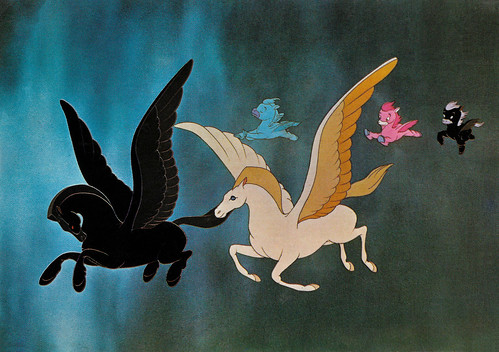
Italian postcard by Grafiche Biondetti, Verona, no. 120. Image: Walt Disney Productions. The Centaurs in the 'Pastoral Symphony' in Fantasia (James Algar, Wilfred Jackson, Hamilton Luske, Ben Sharpsteen, a.o., 1940).

French postcard in the series The Wonderful World of Walt Disney by Editions Kroma, Caissargues, no. 6. Image: Walt Disney Productions. Publicity still for Fantasia (James Algar, Wilfred Jackson, Hamilton Luske, Ben Sharpsteen, a.o., 1940). Hyacinth Hippo and alligator dance partner in the segment Dance of the Hours.
One of the most iconic Mickey Mouse movies
Fantasia (1940) had the working title 'The Concert Feature'. Disney's third full-length animated feature was an experiment. Visualised animation is presented to the beat of classical music. For each of the seven parts, there is an introductory text. One then sees the animated film accompanied by the matching music, played by the Philadelphia Orchestra conducted by Leopold Stokowski.
The film opens without an opening title or logo. One sees a curtain open and the orchestra begins to play Toccata and Fugue in d-moll by Johann Sebastian Bach. The first section of the Toccata and Fugue, directed by Samuel Armstrong, is in live action and shows the orchestra as it plays music, accompanied by abstract light patterns. The picture then switches to an abstract cartoon, based on the works of German artist Oskar Fischinger. Live-action footage is again used for the finale.
The Nutcracker Suite by Pyotr Ilyich Tchaikovsky is the subject of the second segment. This film, also directed by Samuel Armstrong, is all about the changing of the seasons. It starts with summer and then continues through the other seasons until spring. It features many dance pieces. At the centre are animals, plants and fantasy creatures such as fairies. Beforehand, narrator Deems Taylor tells the audience that the ballet 'The Nutcracker' is no longer performed. Something that may have been the case in 1940 but is no longer the case now.
Then follows the film's most famous piece, The Sorcerer's Apprentice, with music by Paul Dukas and directed by James Algar. It is also one of the most iconic Mickey Mouse movies. The Sorcerer's Apprentice follows the story from Johann Wolfgang von Goethe's poem, starring Mickey as the sorcerer's apprentice. He enchants a broomstick so that it will fetch water for him. However, the broom continues its work until the whole room floods, and Mickey is unable to stop it. In a panic, he chops the broom to pieces, but each piece becomes a new broom that starts fetching water again. Eventually, magician Yen Sid (mirroring the name Disney) solves the problem, after which he fires Mickey and sends him away. At the end of the film, Mickey and conductor Leopold Stokowski, both in silhouette, shake hands.
The segment Le Sacre du printemps with music by Igor Stravinsky and directed by Bill Roberts and Paul Satterfield follows the creation of the earth, the first life forms, the flourishing of the dinosaurs and their eventual extinction. Remarkably for Disney, the animals were not anthropomorphised but moved and behaved realistically. Complex techniques were also used to depict volcanoes, boiling lava and earthquakes. Certain details have since been uncovered by palaeontological research, though. Tyrannosaurus rex and Stegosaurus did not live in the same era, the T. rex did not have three fingers on each hand but two, and the theory that dinosaurs died out due to drought and sandstorms has also been disproved.
Then follows a 15-minute interlude, directed by Sharpsteen and David D. Hand, in which the musicians leave the theatre and one is shown the title card of the film. The interlude is followed by a piece of jazz accompanied by a clarinet. With images, the audience is shown how sound waves work. The next segment, 'The Pastoral' with music by Ludwig van Beethoven and directed by Hamilton Luske, Jim Handley, and Ford Beebe, is set at the time of Greek mythology. It shows centaurs, the Olympian gods, satyrs and other mythological creatures, including Valentinian Cupids pairing male and female centaurs. These creatures hold a festival in honour of Bacchus, the god of wine. The festival is disrupted by Zeus, who unleashes a great thunderstorm on the revellers.
Ur Dance, with music by Amilcare Ponchielli and directed by T. Hee and Norm Ferguson, is a parody of ballet in which successive groups of ostriches, hippos, elephants and crocodiles dance. And finally, Night on Bald Mountain/Ave Maria with music by Modest Mussorgsky and Franz Schubert and directed by Wilfred Jackson is a diptych. The first part consists of 'The Night on Bald Mountain', in which at night a demon, Chernabog, awakens on a mountaintop. Béla Lugosi served as a live-action model for Chernabog and spent several days in the studio posing for the illustrators. He summons countless ghosts, monsters and the living dead and holds a ferocious feast. When morning comes and the church bells begin to ring, the demons are driven away and go to sleep. The second shutter immediately follows this and shows a large group of veiled people walking in procession with lanterns through a forest to the tune of 'Ave Maria'. It can be clearly seen that the diptych takes place during All Saints' Night and then connects through the morning.
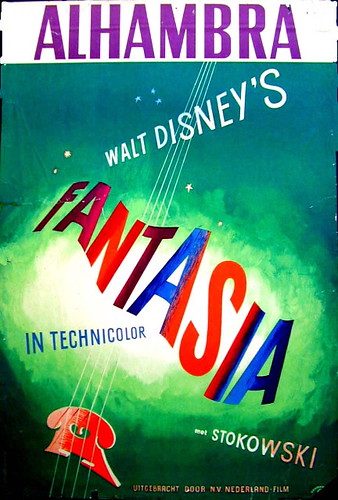
Dutch film poster by Ad Werner for Fantasia (Walt Disney, 1940).

Italian postcard by Grafiche Biondetti, Verona, no. 120. Image: Walt Disney Productions. Publicity still for Fantasia (James Algar, Wilfred Jackson, Hamilton Luske, Ben Sharpsteen, a.o., 1940). Bacchus and Jacchus in the segment The Pastoral Symphony.
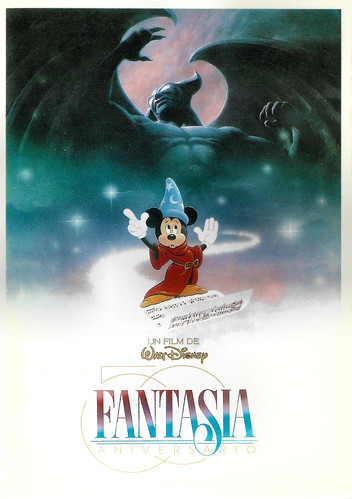
French postcard by Editions Mercuri, no. 223. Image: Walt Disney Productions. French re-issue poster for the 50th Anniversary of Fantasia (James Algar, Wilfred Jackson, Hamilton Luske, Ben Sharpsteen, a.o., 1940).
Disney's first feature-length animated film to flop mercilessly
In the late 1930s, the popularity of Walt Disney's Mickey Mouse began to decline. To make the character more popular again, he made The Sorcerer's Apprentice. It was made as a special production, in which the character would not speak, and the images were accompanied by music by Paul Dukas, 'L'apprenti sorcier' (1897). While work on 'The Sorcerer's Apprentice' was in full swing, Disney met the famous conductor Leopold Stokowski. He offered to act as a conductor for the film and assembled an orchestra of one hundred musicians to record the music. At nine minutes in length, the film became two minutes longer than an average Mickey Mouse movie.
The production costs of The Sorcerer's Apprentice ran to $125,000, an amount Walt Disney knew he would never be able to recoup unless he came up with something bigger. At Stokowski's urging, he decided to expand the concept of The Sorcerer's Apprentice, adding more musical pieces to animated pictures. Disney hired composer and music critic Deems Taylor to talk the films together as narrator. Stokowski came up with the name Fantasia, and this became its final title. The working title of this film was 'The Concert Feature'. Although the Philadelphia Orchestra recorded the music for the film, they are not featured in the film. The orchestra seen playing in the film is made up of local Los Angeles musicians and Disney employees.
Walt Disney wanted Fantasia to be no ordinary film, but more like a signed concert. He had special programme books made for the screening. Every cinema where the film was shown was equipped with 30 or more speakers to give viewers the best possible sound. Fantasia originally had no intro piece or credits. Only a title card could be seen during the intermission section of the film. This title card was moved to the beginning of the film for later releases. Fantasia was first released in 1940 and again in 1985 and 1990.
Fantasia became Disney's first feature-length animated film to flop mercilessly at the box office. Intellectuals and fans of classical music found the film pure kitsch and the general public missed the unpretentious children's entertainment they always associated with Disney. One of the reasons that Fantasia lost so much also had to do with World War II, which deprived Disney of much of its market in Europe. The studio ran into major financial problems and quickly made a simpler feature-length animated film, Dumbo (Ben Sharpsteen, a.o., 1941), which again became a blockbuster. For Disney himself, however, it was a severe blow and he would never again take such a big artistic risk in his career.
The segment Pastorale was most often criticised by filmgoers as pure kitsch. Others criticised the scene in which some female centaurs briefly appear on screen with bare breasts. In The Night on Bald Mountain, too, we see women with bare breasts briefly appearing in the flames. Also, some centaurs are women with black skin and the lower body of a zebra, which comes across as somewhat racist these days. One scene was additionally censored on later video and DVD releases. This is a scene in which a black centaurin polishes the hooves of a white centaurin.
Despite its initially low yield, the film is now considered a classic. The initial wide release was a dismal box-office failure. In later years some theatre chains, which would normally run any Disney release, would not book the reissues of this film. However, by the 1969 reissue, the film attracted considerable interest for its supposedly psychedelic imagery and Disney marketed the film accordingly to take advantage of it. The reissue was successful and the film's reputation and popular appeal grew from that point to when its first home video release in 1991 broke records for sales. A sequel to the film was released in December 1999 under the name Fantasia 2000, initiated by Roy E. Disney.
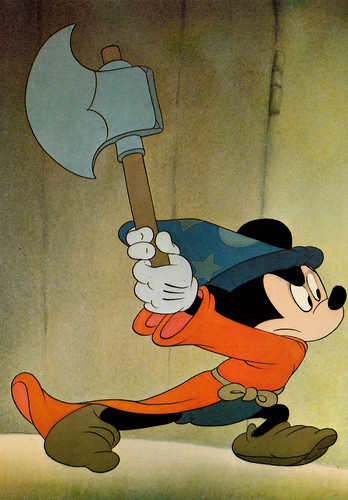
French postcard in the series The Wonderful World of Walt Disney by Editions Kroma, Caissargues, no. 5. Image: Walt Disney Productions. Mickey Mouse as the sorcerer's apprentice in Fantasia (James Algar, Wilfred Jackson, Hamilton Luske, Ben Sharpsteen, a.o., 1940).
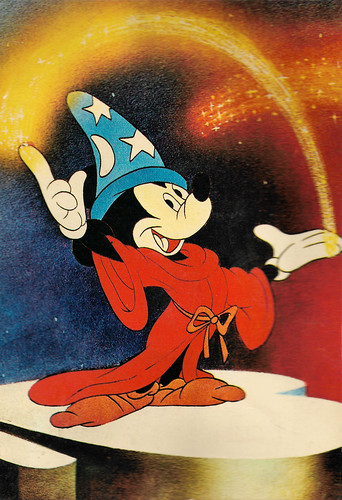
French postcard by Allain. Image: Walt Disney Productions. Mickey Mouse as the sorcerer's apprentice in Fantasia (James Algar, Wilfred Jackson, Hamilton Luske, Ben Sharpsteen, a.o., 1940).
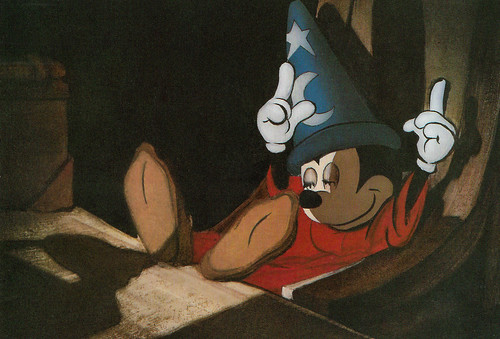
American postcard by Classico San Francisco, no. 328-009 Image: Walt Disney Productions. Mickey Mouse as the sorcerer's apprentice in Fantasia (James Algar, Wilfred Jackson, Hamilton Luske, Ben Sharpsteen, a.o., 1940).

American postcard by Classico San Francisco, no. 328-011 Image: Walt Disney Productions. Mickey Mouse as the sorcerer's apprentice in Fantasia (James Algar, Wilfred Jackson, Hamilton Luske, Ben Sharpsteen, a.o., 1940).

American postcard by Classico San Francisco, no. 328-008 Image: Walt Disney Productions. Mickey Mouse as the sorcerer's apprentice in Fantasia (James Algar, Wilfred Jackson, Hamilton Luske, Ben Sharpsteen, a.o., 1940).
Source: Hal Erickson (AllMovie), Wikipedia (Dutch) and IMDb.
No comments:
Post a Comment